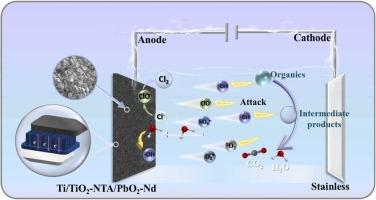High-efficiency Ti/TiO2-NTA/PbO2-Nd anode electrochemical oxidation of coking reverse osmosis concentrated (ROC)
IF 12.2
1区 环境科学与生态学
Q1 ENGINEERING, ENVIRONMENTAL
引用次数: 0
Abstract
In this study, a Ti/TiO2-NTA/PbO2-Nd anode was fabricated for the treatment of coking reverse osmosis concentrate (ROC). The TiO2-NTA interlayer reduced β-PbO2 grain size and increased the PbO2 surface area. Compared to the conventional Ti/PbO2 electrode, the Ti/TiO2-NTA/PbO2-Nd anode demonstrated enhanced electrochemical performance, including higher oxygen evolution potential (OEP), improved hydroxyl radical (•OH) generation, reduced charge transfer resistance, and longer service life. Under optimal conditions (20 mA/cm2, pH 6), COD and TOC removal efficiencies reached 88.0% and 70.8%, respectively, with high degradation efficiency, current efficiency, and low energy consumption (0.23 kWh/g COD). The degradation followed pseudo-first-order kinetics. Reactive oxygen species contributions to ROC degradation were identified through quenching experiments. Recyclability tests (6 and 80 cycles) and accelerated service life tests confirmed the anode's excellent performance and stability. 3D EEM and GC-MS analysis further demonstrated the effective removal of refractory organics from ROC. These results highlight its potential for long-term wastewater treatment applications.

求助全文
约1分钟内获得全文
求助全文
来源期刊

Journal of Hazardous Materials
工程技术-工程:环境
CiteScore
25.40
自引率
5.90%
发文量
3059
审稿时长
58 days
期刊介绍:
The Journal of Hazardous Materials serves as a global platform for promoting cutting-edge research in the field of Environmental Science and Engineering. Our publication features a wide range of articles, including full-length research papers, review articles, and perspectives, with the aim of enhancing our understanding of the dangers and risks associated with various materials concerning public health and the environment. It is important to note that the term "environmental contaminants" refers specifically to substances that pose hazardous effects through contamination, while excluding those that do not have such impacts on the environment or human health. Moreover, we emphasize the distinction between wastes and hazardous materials in order to provide further clarity on the scope of the journal. We have a keen interest in exploring specific compounds and microbial agents that have adverse effects on the environment.
 求助内容:
求助内容: 应助结果提醒方式:
应助结果提醒方式:


